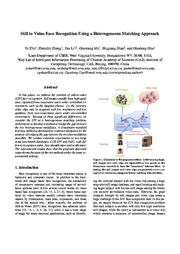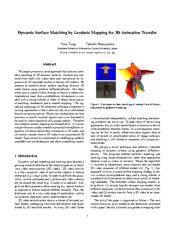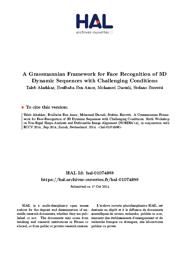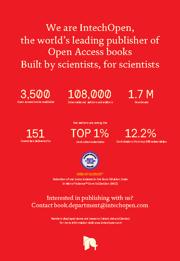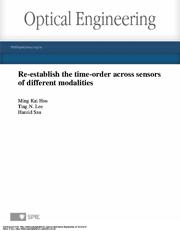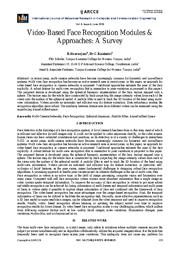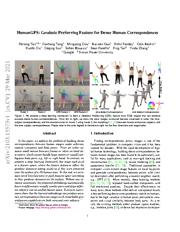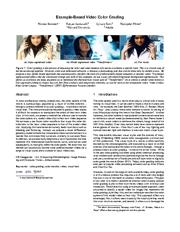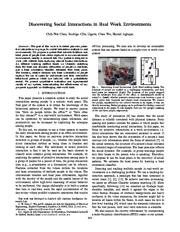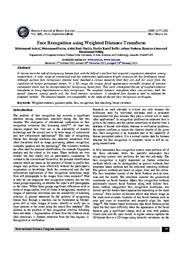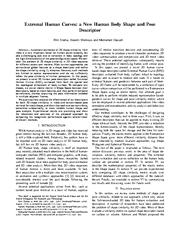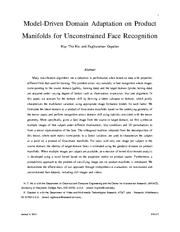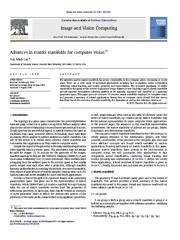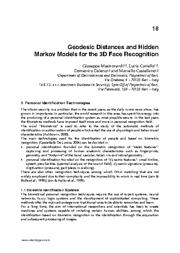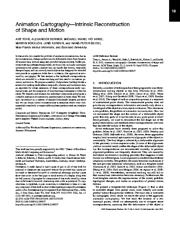A copy of this work was available on the public web and has been preserved in the Wayback Machine. The capture dates from 2017; you can also visit the original URL.
The file type is application/pdf.
Filters
Still to video face recognition using a heterogeneous matching approach
2015
2015 IEEE 7th International Conference on Biometrics Theory, Applications and Systems (BTAS)
In this paper, we address the problem of still-to-video (S2V) face recognition. ...
Because of these significant differences, we consider the S2V as a heterogeneous matching problem, and propose to develop a method to bridge the gap between the two heterogeneous modalities. ...
A kernel function is applied so that all the continuous subspaces on geodesic flow can be used to model the relationship between still images and video clips. ...
doi:10.1109/btas.2015.7358798
dblp:conf/btas/ZhuZLMSG15
fatcat:wxapjmavy5bpfdnibemqpcyxeu
Dynamic surface matching by geodesic mapping for 3D animation transfer
2010
2010 IEEE Computer Society Conference on Computer Vision and Pattern Recognition
We propose to perform dense surface matching between 3D video frames using geodesic diffeomorphisms. ...
Our algorithm uses a coarse-to-fine strategy to derive a robust correspondence map, then a probabilistic formulation is coupled with a voting scheme in order to obtain local unicity of matching candidates ...
In this paper, we present an novel approach for dense matching of dynamic surfaces in 3D videos using geodesic maps. ...
doi:10.1109/cvpr.2010.5539806
dblp:conf/cvpr/TungM10
fatcat:zddkfftz6ncuxoiecsu5kyjhqi
A Grassmannian Framework for Face Recognition of 3D Dynamic Sequences with Challenging Conditions
[chapter]
2015
Lecture Notes in Computer Science
This approach allows us to compare two 3D face videos and to compute statistics (e.g., mean, clustering of a set of 3D face videos). ...
However, evaluations on unconstrained face recognition (FR) from 2D still images and videos, such as the Multiple Biometric Grand Challenge [16] showed that FR under pose variations is still a distant ...
doi:10.1007/978-3-319-16220-1_23
fatcat:3sdavvp5y5fsva23hwq5hju4wu
3D Face Recognition
[chapter]
2011
New Approaches to Characterization and Recognition of Faces
This method includes, face finding, landmark finding, and template computation. They used weighted sum rule to fuse shape and texture scores. ...
Nonetheless, in spite of the various facial recognition systems which already exist, many of them have been unsuccessful in matching up to expectations. 2D facial recognition systems are constrained by ...
A video contains temporal information (e.g., movements of facial features) as well as multiple instances of a face, so it is expected to lead to a better face recognition performance compared to still ...
doi:10.5772/18696
fatcat:3uoguw3bo5gmlpor63xbid25vy
Re-establish the time-order across sensors of different modalities
2011
Optical Engineering: The Journal of SPIE
We have thus demonstrated the time-order helps us associate a video submanifold with the acoustic manifold that solves the 5 W's challenge. ...
face C, also consider β to be their two nearest neighbors. ...
Jeffrey Jenkins at NVESD and Professor Harrington, Professor Carroll, and Professor Doroslovacki at ECE Department in GWU for useful discussions. ...
doi:10.1117/1.3562322
fatcat:ec3p6bfw4banrd4y6izfpzawuu
Video-Based Face Recognition Modules & Approaches: A Survey
2019
IJARCCE
A particle filter is used to track the 3D location of the head using multiview information. Videos provide an automatic and efficient way for feature extraction. ...
The similarity between feature sets from different videos can be measured using the reproducing Kernel Hilbert space. ...
But the term has frequently been used to recognize faces across pose variations. This ambiguity does not cause any problem for recognition with still images. ...
doi:10.17148/ijarcce.2019.8623
fatcat:z4szjyybxjdj5p6rglxdoijpkq
HumanGPS: Geodesic PreServing Feature for Dense Human Correspondences
[article]
2021
arXiv
pre-print
To this end, we introduce novel loss functions to push features apart according to their geodesic distances on the surface. ...
In contrast, we propose a deep learning framework that maps each pixel to a feature space, where the feature distances reflect the geodesic distances among pixels as if they were projected onto the surface ...
While the triplet loss penalizes all the non-matching pixels equally (i.e., further apart compared to the matched pixel), the dense geodesic loss, instead, pushes features between non-matching pixels apart ...
arXiv:2103.15573v1
fatcat:m6e6rtpdare7pcz3uq6ck6b5vi
Example-based video color grading
2013
ACM Transactions on Graphics
This allows us to process the input sequence (a) to reproduce the characteristic visual style of "Transformers" (b) to convey a similar tense mood (c). ...
Instead, we propose a novel differentialgeometry-based scheme that interpolates these transformations in a manner that minimizes their curvature, similarly to curvature flows. ...
We thank the authors of all the videos used to demonstrate the techniques in this paper. We also thank the SIGGRAPH reviewers for their helpful comments. ...
doi:10.1145/2461912.2461939
fatcat:paju5lned5dwxm35inxonjd26e
Discovering social interactions in real work environments
2011
Face and Gesture 2011
We propose a system that extracts locations and head poses of people from videos captured in an unconstrained environment, namely a research lab. ...
Our system is designed to work with realistic data capturing natural human interactions. ...
We would like to thank Amir Hossein Khalili and Parinaz Sayyah for useful discussions and helping with the collection of the data. ...
doi:10.1109/fg.2011.5771376
dblp:conf/fgr/ChenUWA11
fatcat:pgsklrq6affvffribqjrad5ixa
Face recognition using weighted distance transform
2013
Proceedings of 2013 10th International Bhurban Conference on Applied Sciences & Technology (IBCAST)
A standard face dataset is used to validate the proposed method. The obtained results are comparable to the state-of-the-art face recognition techniques. ...
This work investigates the use of weighted distance transform to bring improvements in face recognition. ...
Both the commercial and the law enforcement applications of face recognition techniques range from still photographs to the images from video sequence 4 . ...
doi:10.1109/ibcast.2013.6512145
fatcat:cj2awy7t5jblxotoizh42a5nom
Extremal human curves: A new human body shape and pose descriptor
2013
2013 10th IEEE International Conference and Workshops on Automatic Face and Gesture Recognition (FG)
in multiple adjacent frames. ...
Automatic estimation of 3D shape similarity from video is a very important factor for human action analysis, but also a challenging task due to variations in body topology and the high dimensionality of ...
[11] proposed 3D shape similarity metrics for 3D video sequences of people, using time filtering and shape flows obtained via invariant-rotation shape histogram. ...
doi:10.1109/fg.2013.6553760
dblp:conf/fgr/SlamaWD13
fatcat:w7plrqgjcjec5iqblvnhjtb2hi
Model-Driven Domain Adaptation on Product Manifolds for Unconstrained Face Recognition
2014
International Journal of Computer Vision
We demonstrate the effectiveness of our approach through comprehensive evaluations on constrained and unconstrained face datasets, including still images and videos. ...
For cases with only one image per subject in the source domain, the identity of target domain faces is estimated using the geodesic distance on product manifolds. ...
We also address the problem of image set matching which is relevant to video-based face recognition where multiple frames in an video provide evidence related to the facial identity. ...
doi:10.1007/s11263-014-0720-x
fatcat:rh52qz6rrnfvvn7lfwk6l7lh7a
Advances in matrix manifolds for computer vision
2012
Image and Vision Computing
There are a wide range of important applications including face recognition, action recognition, clustering, visual tracking, and motion grouping and segmentation. ...
The increased popularity of matrix manifolds is due partly to the need to characterize image features in non-Euclidean spaces. ...
The author also thanks the anonymous reviewers for their valuable comments which helped to improve the quality of this manuscript. ...
doi:10.1016/j.imavis.2011.08.002
fatcat:wdzjikdbpfgobgopkvc4rmqkqy
Geodesic Distances and Hidden Markov Models for the 3D Face Recognition
[chapter]
2010
Face Recognition
., 2003) : Holistic matching methods. These methods use the whole face region as the raw input to a recognition system. ...
Indexing this multimedia content by face detection, face tracking, face recognition, and face change detection is important to generate segments of coherent video content for video browsing, skimming, ...
Different MDS methods can be derived using different embedding error criteria (Borg et al. 1997) . ...
doi:10.5772/8948
fatcat:fmirckp2cfb6fnlnp3jxvxovr4
Animation cartography—intrinsic reconstruction of shape and motion
2012
ACM Transactions on Graphics
Our approach is motivated by cartography: We first estimate a few landmark correspondences, which are extended to a dense matching and then used to reconstruct geometry and motion. ...
techniques to refine the result. ...
ACKNOWLEDGMENTS We would like to thank Leonidas Guibas and Qi-Xing Huang for extensive discussions on intrinsic matching and landmark-based techniques. ...
doi:10.1145/2159516.2159517
fatcat:zwae6bb35bgk7pez5h7farnxee
« Previous
Showing results 1 — 15 out of 1,312 results

